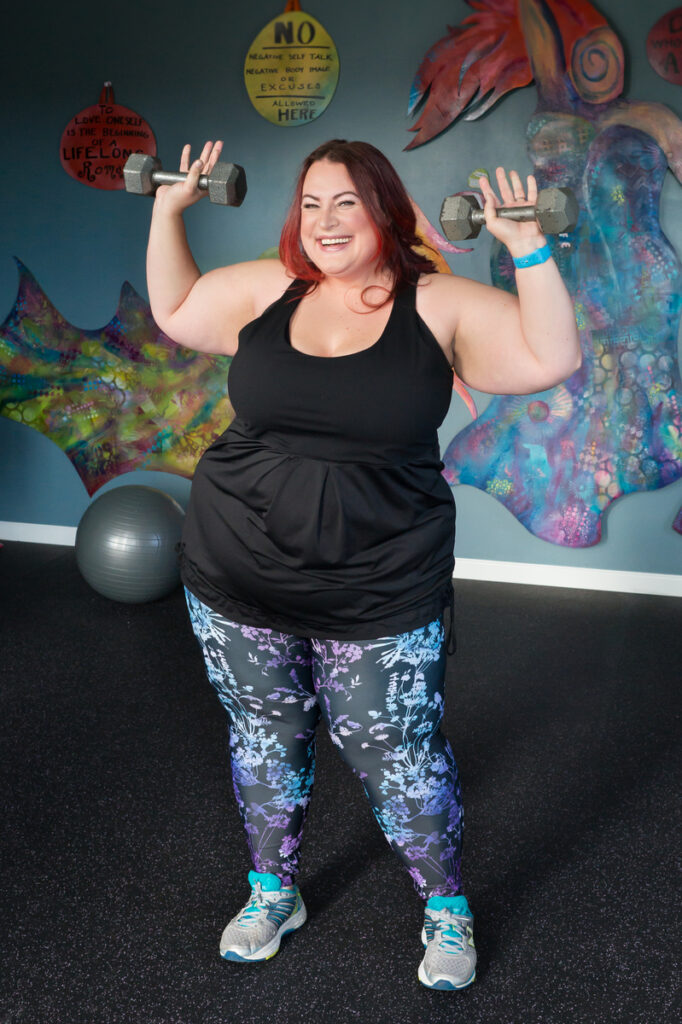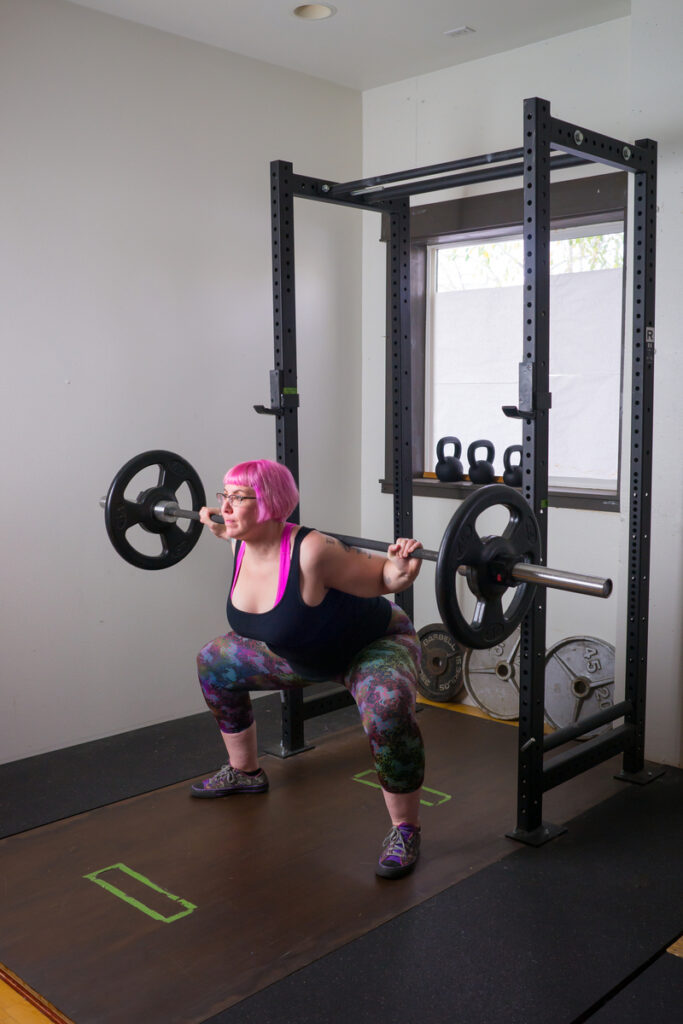Strength training is for EVERY body! You may have heard about strength training before, but have you heard of size-inclusive strength training? This way of training benefits everyone, all body sizes, because it encourages listening to your body and moving away from society’s messages that we should always be unhappy with our bodies.
Ready to see how it can apply to you? Awesome.
What is size-inclusive strength training?
In mainstream fitness, being “fit” is linked to a specific body size: thin. When you walk into a gym, it’s assumed you want to lose weight, because isn’t everyone striving for that “fit” look?
Today we’re going to talk about why that’s not true.
Fit is not a body size.
Weight stigma is very real, and rears its ugly head everywhere in the fitness world. Thanks to diet culture, our society, including the mainstream fitness world, is obsessed with the idea of getting thinner, becoming smaller.
What is diet culture, you might ask?

Diet culture is a system of beliefs that values thinness above all else, even at the expense of a person’s health. Most activities are only associated with how many calories you’re burning, and diets are a constant. Diet culture shows up… pretty much everywhere. When you go to gyms or look at fitness accounts on social media, the focus is on weight loss and achieving a thinner body. Coaches will assume you want to lose weight before they even ask about your fitness goals. It looks like praising people who have lost weight, even though the reason might be because they have been sick or struggling.
When it comes to any sort of activity, the benefits always include “and it helps you burn calories!” Even my under-desk treadmill, which I got purely to get more movement in my day, tells me speed, time, distance, and CALORIES BURNED. Diet culture pushes people to view workouts as either punishment or preparation for eating “bad” food.
But there’s a part of the fitness world that, while it still feels the effects of diet culture, is a place where you’re accepted for who you are right now. Where you can strength train because it makes you feel good, not because you’re trying to be smaller. Where you can listen to your body and make the best choices for yourself.
That place is size-inclusive strength training!
Toxic Fitness Culture
The effects of diet culture on the fitness world has led to a toxic fitness culture (term coined by Ilya Parker of Decolonizing Fitness). Toxic fitness culture promotes pushing past your limits and ignoring what your body’s trying to tell you. You’ve probably heard some of these “motivational” sayings:
- “No pain, no gain.”
- “Never skips a day.”
- And the dreaded “Nothing tastes as good as skinny feels.” (It feels icky just writing that out actually…)
This shows up in more ways than just pushing weight loss.
It also looks like pressuring men to always be working towards bigger muscles and getting ripped. It looks like women only getting exercises for a larger booty while being told to make sure they don’t get bulky. There’s nothing wrong with training to build muscle, but it’s no longer okay when you’re pressured into it or shamed for not doing it. It’s an individual choice!
Toxic fitness culture makes going to the gym become linked with being a good and moral person. It places blame on the individual person for how their body shows up in the world instead of addressing systemic issues that cause fitness to be inaccessible for many people.
Body Neutrality
Size-inclusive strength training generally uses a body-neutral approach to fitness. Body neutrality is about focusing on what your body does instead of what it looks like.
You might be more familiar with the term body positivity. While started with good intentions, the term and the movement have gotten a bad rap because of overuse and misinterpretation. Because the focus of body positivity is on loving your body and how it looks, many people struggle to connect with the idea. This is where body neutrality comes in!
It encourages you to feel neutral about your body and take appearance out of the equation. You don’t have to love your body (body positivity), and you don’t have to hate your body (diet culture). You can acknowledge your body for what it does. For example, you can make a statement like “I like my legs because they help me squat well,” and take appearance out of the equation entirely. Because of all the damage diet culture has done, body neutrality can be a much more obtainable way to connect with your body than body positivity.
How to Spot a Size Inclusive Strength Coach
They Use Inclusive Language
A size-inclusive strength coach will use inclusive language when talking about training. Here are some of the messages you might see from a coach or gym:
- Every body is worthy.
- Everyone deserves to move their body.
- Fit is not a size.
- Heath doesn’t have a size.
- They encourage fitness for joy and good feelings, unrelated to appearance.
- They accept your body as it is now, not “the potential”
- They encourage balance with movement, not always pushing harder.
No Weight Loss or Diet Talk
You won’t hear talk about intentional weight loss from a size-inclusive coach, and they won’t suggest any diets for you to follow. (PS a fitness trainer asking you to follow any sort of meal/diet plan is a red flag in the first place.) They don’t assume you have a weight loss goal when you walk into a fitness space. Instead, these coaches might discuss ways your body might change as you start strength training so you’re prepared for them, without encouraging you to want to be smaller.
You also won’t experience them asking you to record your weight, take measurements, or take before and after photos. When a coach understands that weight loss isn’t an automatic fitness goal, those “necessary” measurements aren’t so necessary anymore.

They Help You Modify Exercises and Give Options/Variations
A size-inclusive strength coach will support switching exercises and have a toolbox of options for you to use during workouts. Instead of focusing on the most “correct” form, they’re focused on you doing an exercise in a way that a) is safe, and b) is comfortable for your body. Because everyone’s body is different, people will feel comfortable with different exercise variations.
A size-inclusive coach also doesn’t create an unnecessary hierarchy for these variations. You won’t hear phrases like “advanced _____” or “beginner _____” as variations names. There’s only what is more or less challenging for your body specifically. All of these exercise variations are valid and your ability to choose the best option is important.
They Encourage Listening to Your Body and Prioritizing Rest
As I discussed above, a big part of toxic fitness culture is pushing past your limits and not listening to your body. Size-inclusive strength training is the opposite. An inclusive coach will encourage you to choose what’s best for you. You are the expert on your own body after all! Sometimes it takes people a while to feel comfortable with this choice, since diet culture is all about taking that choice away from you. It’s an ongoing process your coach can help you with.
A size-inclusive coach will also encourage resting when you feel like your body needs to. I often need to encourage my clients to do less when it comes to workouts, because they’re programmed to always try to do more and push harder. Rest is important both during and in between workouts. It’s an important part of getting stronger and not overtraining.
Size-inclusive coaches are also sensitive to past fitness trauma. They know how common it is for people to have bad experiences with coaches and gyms, and they are there to support you through finding the positives in fitness. They will ask you about how you’re feeling and whether you’re okay with what’s happening instead of pushing you to try something that is triggering or takes you too far out of your comfort zone.
Inclusive Visuals
One immediate way to tell if someone is inclusive or not is in their marketing and (if in person) gym visuals. Do they show people of different body sizes, and are those people celebrated for who they are in the pictures? Or do you only see people of different sizes in before photos?
For more size inclusive strength training content:
This is a very (very) brief overview of size-inclusive strength training, but here are some amazing people you can follow to learn more!
- Louise Green, creator of the Size Inclusive Fitness Specialist certification
- Meg Boggs
- Chrissy King
- Roz The Diva
- Justice Williams, founder of Fitness 4 All Bodies
- Tasheon Chillous
- Laura Khoudari
- Lauren Leavell
- Charles Abouzied
- The Body Positive Fitness Alliance and it’s members/the coaches they promote
Sarah Siertle
Hey! I'm Sarah!
I'm an inclusive strength & movement coach who helps people get hella strong so they can have fun and live their lives in full color!
My coaching is beginner-friendly, movement-based, and size-inclusive. I believe in coaching that is kind, not shaming or judgmental as so many fitness experiences are.
If you're ready to start your strength journey, you can check out your training options or get started with a free workout!
Comments